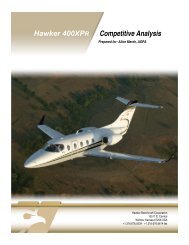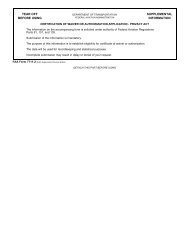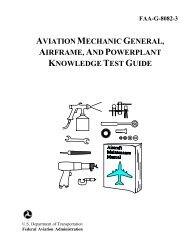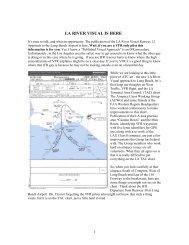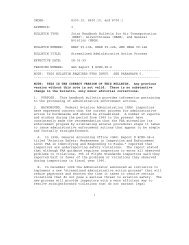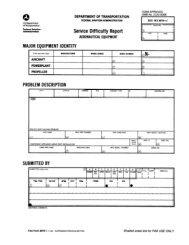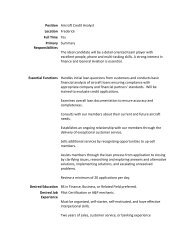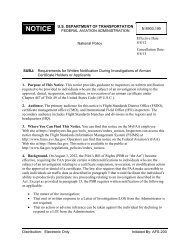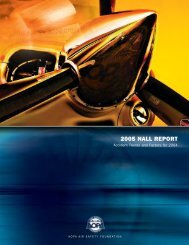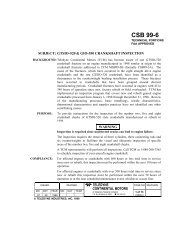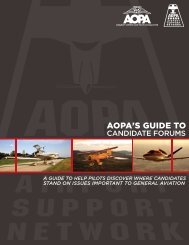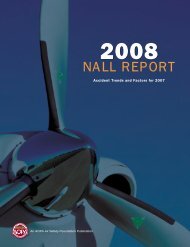Joseph T. Nall Report - Aircraft Owners and Pilots Association
Joseph T. Nall Report - Aircraft Owners and Pilots Association
Joseph T. Nall Report - Aircraft Owners and Pilots Association
Create successful ePaper yourself
Turn your PDF publications into a flip-book with our unique Google optimized e-Paper software.
Conclusions<br />
Conclusions<br />
HOW SAFE IS GENERAL AVIATION?<br />
In a 1972 decision, the U.S. Supreme<br />
Court said that “safe is not the equivalent<br />
of risk free.” If safe meant freedom from<br />
the possibility of harm, few human activities<br />
would meet the st<strong>and</strong>ard. In fact, the<br />
only way to eliminate risk from any activity<br />
is to avoid participating in it. While<br />
risk does not guarantee injury or make an<br />
activity unsafe, it should not be ignored.<br />
By analyzing mishaps, we can learn about<br />
potential risks <strong>and</strong> take proactive steps to<br />
control them.<br />
1999—A FINAL R EVIEW<br />
1999 continued the trend of the last<br />
several years with declining accident<br />
rates—both total <strong>and</strong> fatal. A slight<br />
increase in the number of accidents was<br />
offset by an increase in flight hours. A<br />
slight decrease in the number of fatal accidents<br />
was coupled with a slight increase<br />
in the number of fatalities. None of these<br />
differences was significant, however, so<br />
the fact remains that 1999 was a<br />
typical GA accident year.<br />
The human factor continues to predominate<br />
the GA accident picture, as it<br />
does in commercial aviation. As the aviation<br />
environment becomes increasingly<br />
complex, its challenges will also increase.<br />
As expected, pilot involvement in accident<br />
causation in 1999 was high.<br />
Approximately 60 to 90 percent of aviation<br />
accidents are typically related to<br />
human causes <strong>and</strong> 1999 was no exception.<br />
We continue to suffer the bulk of<br />
accidents in takeoff <strong>and</strong> l<strong>and</strong>ing <strong>and</strong> suffer<br />
the majority of fatalities due to maneuvering<br />
flight <strong>and</strong> weather encounters.<br />
In previous years, we have cited studies<br />
that compared accidents due to skill<br />
<strong>and</strong> decision types of errors. Faulty decision<br />
making tends to result in deaths <strong>and</strong><br />
serious injuries while skill-related types<br />
of problems are implicated in the “fender<br />
benders.” Many of the less severe accidents<br />
that are attributable to skill problems<br />
also often have a component of<br />
faulty decision making where pilots have<br />
placed themselves in situations exceeding<br />
their skills.<br />
In 1999, these facts were evident as in<br />
previous years. While VFR into IMC accidents<br />
declined somewhat, this area still<br />
continues to claim too many lives. Few of<br />
these accidents were the direct result of<br />
insufficient skills, even where noninstrument-rated<br />
pilots were involved. Pilot<br />
planning <strong>and</strong> decision making are also evident<br />
in problem areas such as fuel management.<br />
All pilots are equipped with the<br />
knowledge to avoid this problem. It<br />
remains the responsibility of all pilots to<br />
plan <strong>and</strong> execute their flights safely <strong>and</strong><br />
within their training <strong>and</strong> skill levels.<br />
❝Safe is not the equivalent<br />
of risk free.❞<br />
— U.S. Supreme Court, 1972<br />
Pilot reports (pireps) are extremely<br />
useful components of aviation weather<br />
reporting. These reports submitted by<br />
pilots during or immediately after flight<br />
are sometimes the best <strong>and</strong> often the only<br />
way of knowing the extent <strong>and</strong> severity of<br />
weather conditions ahead. The problem<br />
with pireps is they tend to be scarce when<br />
they are most needed.<br />
To improve pirep quality <strong>and</strong> quantity<br />
ASF created the SkySpotter program,<br />
online at www.aopa.org/asf/skyspotter/.<br />
<strong>Pilots</strong> who wish to participate in the program<br />
complete an ASF training program<br />
on the Internet <strong>and</strong> agree to forward<br />
pireps on every cross-country flight. This<br />
information is collected by Flight Service<br />
<strong>and</strong> ATC as available, to be disseminated<br />
to pilots <strong>and</strong> the National Weather Service<br />
to validate forecasts.<br />
A large number of maneuvering accidents<br />
reflect another type of decision problem.<br />
While weather-related accidents often<br />
are related to errors in planning, information<br />
gathering, <strong>and</strong> in-flight decision making,<br />
many of these maneuvering accidents<br />
are the result of reckless disregard of safe<br />
operating practices. The actions that precede<br />
these accidents are not usually mistakes<br />
in judgment—they are deliberate.<br />
Other causes continue to affect the<br />
accident picture to a lesser but still consistent<br />
degree. Alcohol <strong>and</strong> drug use continues<br />
to be evident in GA accidents, but to a<br />
much lesser degree than on the highways.<br />
The fact that it is low is most likely a<br />
reflection of the type of people that are<br />
involved in aviation.<br />
The pilot-aircraft environment equation<br />
is the key to controlling risk. A capable<br />
pilot in a well maintained aircraft with<br />
proper consideration for flight conditions is<br />
one of the safer forms of transportation.<br />
Disregard any part of the equation <strong>and</strong> the<br />
risk will rise accordingly, as it does in any<br />
other performance activity.<br />
27



